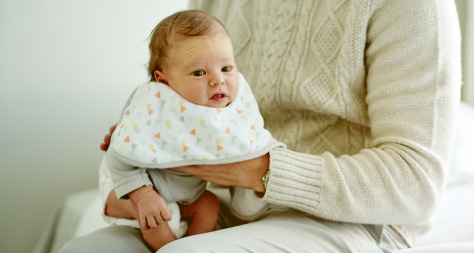What causes wind in babies?
Wind in babies is caused by trapped air bubbles in their stomachs that they are unable to expel themselves and therefore need someone’s help in doing so. Wind is extremely common, especially from the newborn stage to about three months, as a baby’s digestive system matures and they get used to coping with milk. Some babies can suffer for several months with trapped wind whereas others may have no problems at all – it really is luck of the draw and differs from baby to baby.

Who suffers from wind?
Although it is commonly thought that breastfed babies suffer less than bottle fed babies, this isn’t necessarily the case. It is thought that bottle fed babies can take down too much air while sucking on the teat of the bottle while babies feeding from the breast are better able to control the flow of milk and therefore trap less air (they are also more likely to be fed in an upright position which also helps). However both can occur and sometimes premature babies suffer more with wind as well. Crying can also cause air to become trapped and can cause pain. The pain from trapped wind typically manifests in babies drawing their legs up to their chests, thrashing around and screaming after a feed and breaking off in discomfort halfway through a feed.
How to burp a baby
The most effective and tried and tested way to ease wind in a young baby is to burp them after each feed, ensuring that all troublesome wind comes up rather than sits in the tummy causing your little one pain. Some people also advocate burping during a feed, a more recent school of thought however, is to wait until the baby has completely finished its feed rather than encourage excess air takedown by breaking them off mid feed which might annoy them. The main thing to remember when burping your baby is to keep their back (and therefore windpipe) as straight as possible to encourage the air bubbles to reach the surface, while all the while supporting their head and neck.
Which burping positions are best?
Many parents find it easiest to pop their babies onto their shoulder and rub their back in firm but rhythmic motions until they burp…often while walking around which can also help. Other suggestions are to sit your baby on your lap, facing away from you, and supporting their head and neck straighten their back while very gently pushing them forwards and rubbing their back with your free hand. Some babies will only burp when facing down with a little gentle pressure directly onto the stomach – this can be achieved by placing them face down on your lap while supporting their head and obviously making sure they can still breathe!
Are there any OTC treatments for wind?
Due to the air formulating in tiny air bubbles in a baby’s stomach it is much harder to expel than usual. There are some over the counter remedies such as Infacol which contain simeticone to help these tiny air bubbles join together to make bigger air bubbles, thus making it easier for a baby to bring them up. Infacol can be used from birth onwards and is administered directly into the baby’s mouth via a plastic dropper. Other mums swear by that old favourite of gripe water for wind in babies – but gripe water can only be used from when baby is 28 days old - it’s a completely herbal remedy containing sodium bicarbonate and dill seed oil to neutralise excess acid and warm and relax your baby’s tummy respectively. Almost all gripe water formulations available now are both sugar and alcohol free (in contrast to when it came out years ago). It is important to be aware that the evidence regarding these products is very limited so they are not always effective for all babies.
Any other remedies for trapped wind?
A baby massage can also help with trapped wind in babies and in fact can also be a good way for mothers to bond with their new arrivals. Massage teachers can show ways and directions to apply gentle pressure onto the stomach which will help alleviate pain and discomfort. Aside from that, the main thing to remember is to keep your baby as upright as possible during a feed, whether breast or bottle fed, and if bottle fed always make sure the milk is covering the full area of the teat to avoid any excess air sneaking in which can be gulped down.
Talk to your health visitor
Do contact your health visitor if trapped wind is ongoing and if you are finding it increasingly difficult to cope with your little one's persistent crying. Persistent and severe wind can be a sign of an allergy if ongoing so do share any concerns with your health visitor.